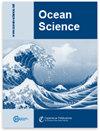峡湾环流使中纬度漫长而深邃的入海口形成持久的地下水团
IF 4.1
3区 地球科学
Q2 METEOROLOGY & ATMOSPHERIC SCIENCES
引用次数: 0
摘要
摘要峡湾是连接流域和海洋的深近岸地带,通常表现为河口。在一些峡湾,冬季的强卡巴他风(也称为北极外流风事件)可导致表层下水域冷却和复氧,其影响可持续到第二年秋季,2019 年在加拿大不列颠哥伦比亚省布特湾观察到了这种情况。我们利用高分辨率三维海洋模式夏季模拟,研究了布特湾富氧冷凉表层下条件持续存在的机制。在这个长而深的峡湾中,咸水外流下的缓慢残余环流(以及随之而来的缓慢平流)是冷的次表层水团在秋季条件发生变化(即风混合开始增强,淡水强迫减少)之前保持原位的主要原因。另一个机制是副表层水团的存在提供的正反馈,因为它进一步减少了本已微弱的剩余环流。这些发现适用于任何类似的在冬季经历卡塔巴赫风的深长峡湾,它们不仅对水团的保存有影响,而且对其他可能的次表层特征(如污染物溢出、浮游幼虫)也有影响。此外,确定允许持续低温和含氧条件的机制,对于了解在变暖和脱氧的海洋中可能存在的生态庇护区至关重要。本文章由计算机程序翻译,如有差异,请以英文原文为准。
Fjord circulation permits a persistent subsurface water mass in a long, deep mid-latitude inlet
Abstract. Fjords are deep nearshore zones that connect watersheds and oceans, typically behaving as an estuary. In some fjords, strong katabatic winds in winter (also known as Arctic outflow wind events) can lead to cooling and reoxygenation of subsurface waters, with effects lasting until the following autumn, as observed in 2019 in Bute Inlet, British Columbia, Canada. We used high-resolution, three-dimensional ocean model summer simulations to investigate the mechanisms allowing for the persistence of these cool, oxygen-rich subsurface conditions in Bute Inlet. The slow residual circulation underneath the brackish outflow (and consequent slow advection) in this long, deep fjord is a main reason why the cold subsurface water mass stays in place until conditions change in autumn (i.e., start of stronger wind mixing and reduced freshwater forcing). Another mechanism is a positive feedback provided by the presence of this subsurface water mass, since it further reduces the already weak residual circulation. These findings are applicable to any similar long, deep fjord that experiences katabatic winds in winter, and they could have implications not only for the preservation of water masses but other possible subsurface features (e.g., pollutant spills, planktonic larvae). Furthermore, the identification of mechanisms that permit persistent cold and oxygenated conditions is key to understanding potential areas of ecological refugia in a warming and deoxygenating ocean.
求助全文
通过发布文献求助,成功后即可免费获取论文全文。
去求助
来源期刊

Ocean Science
地学-海洋学
CiteScore
5.90
自引率
6.20%
发文量
78
审稿时长
6-12 weeks
期刊介绍:
Ocean Science (OS) is a not-for-profit international open-access scientific journal dedicated to the publication and discussion of research articles, short communications, and review papers on all aspects of ocean science: experimental, theoretical, and laboratory. The primary objective is to publish a very high-quality scientific journal with free Internet-based access for researchers and other interested people throughout the world.
Electronic submission of articles is used to keep publication costs to a minimum. The costs will be covered by a moderate per-page charge paid by the authors. The peer-review process also makes use of the Internet. It includes an 8-week online discussion period with the original submitted manuscript and all comments. If accepted, the final revised paper will be published online.
Ocean Science covers the following fields: ocean physics (i.e. ocean structure, circulation, tides, and internal waves); ocean chemistry; biological oceanography; air–sea interactions; ocean models – physical, chemical, biological, and biochemical; coastal and shelf edge processes; paleooceanography.
 求助内容:
求助内容: 应助结果提醒方式:
应助结果提醒方式:


